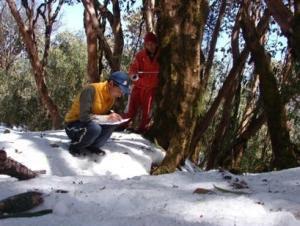Sunita Pradhan
Other projects
30 Jan 2013
Tourism in Red Panda Habitats of Singhalila and Neora Valley National Parks, Darjeeling Himalayas, India – An Assessment for Appropriate Strategies
10 Sep 2015
Tourism in Red Panda Habitats of Darjeeling-Sikkim Himalaya – Assessing and Implementing Appropriate Strategies
Red Panda, Ailurus fulgens, is an endangered species (IUCN, 2002). It is distributed across Eastern Himalayas in Nepal, India, Bhutan, extending into Myanmar and China. Red panda is threatened throughout this range by loss and fragmentation of habitat and direct harvest. However, the relative importance of these threat factors across the sub regions is still not well understood.

In India, red panda, Ailurus fulgens is distributed in Darjeeling, Sikkim and Arunachal Pradesh. The only study and conservation effort of red panda so far in India has been in the Singhalila National Park, Darjeeling (Pradhan, 1998). The present project, focused in Neora Valley National Park (80° 45' – 88° 50' E, 26° 52' 27° 7' N; altitude: I38 – 3I55 msl) in Darjeeling is a follow up of the conservation efforts in the Singhalila National Park, Darjeeling. The project aims to bridge gaps in information through:

(a) assessment distribution pattern, status of red panda
(b) identify threats
(c) develop the first draft of conservation strategy for the species in Darjeeling.
The present study is intended to extend to Sikkim and Arunachal Pradesh in subsequent phases for development of red panda conservation action plan in India. The project is not only a single species conservation program but has its importance in having a broader impact in the conservation of the Eastern Himalaya Broadleaf and Conifer Forest ecoregion of the Eastern Himalayas.
Therefore the overall aim of the project is intended to fill in this information gap on red panda to contribute towards developing a comprehensive long term strategy for conservation of the Red panda in India.
Project Work Plan:
Phase I - Reconnaissance
Rapport building with local people and stakeholders. Local assistants will be identified and trained on research methods.
Phase 2 - Red Panda Monitoring
Monitoring of red panda would be done basically from during three seasons - post monsoon, winter and pre-monsoon, along transects to assess their distribution pattern and relative abundance.
Phase 3 - Threat Assessment
Quantification of threats in the field would during the monitoring phase. Meetings will be held with local people to understand the dynamics of the threats to Red panda and its habitat, during the monsoon period.
Phase 4 - Draft Conservation Plan
Along with field data analysis, several rounds of consultations will be conducted to formulate a draft conservation plan. Reports writing would be done.